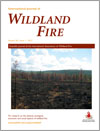International Journal of Wildland Fire
Volume 26
Number 1 2017
The research investigated different understandings of risk and resilience in emergency management. Findings indicate that uncertainty tends to be framed as knowable risk. Resilience consequently appears as the product of risk reduction and response. We argue that this limited understanding affects people’s ability to know their risk, make decisions and, therefore, be resilient.
This paper presents a probabilistic model for predicting house damage due to wildfire at the mesoscale. The model is based on Bayesian networks (BN), and its inputs are readily available spatiotemporal datasets. The BN is coupled with a GIS for a spatially explicit estimate of expected house damages. Numerical investigations are carried out for Cyprus.
This study presents an empirical model for describing the effect of fuel moisture content on the spread rate of forest fires in litter and shrubland fuel complexes. The model was fitted using data from laboratory experiments, and validated using field experiments and wildfires.
This work showed that the use of Landsat satellite imagery through the differenced Normalized Burn Ratio (dNBR) index provides a valuable approach for the quantification and mapping of burn severity in eastern boreal forests of Canada, which is useful in post-fire ecology research and management.
Charcoal was collected from mosses and traps after a wildfire in NE China. Although both macroscopic and microscopic charcoals were found to have been dispersed across long distances, their concentrations clearly distinguished burnt areas from unburnt areas. The burnt area and the vegetation were major factors in determining charcoal abundances.
Empirical functions to predict bulk density as a function of height in 4-year-old chaparral were developed for two species of shrub fuels. Bulk density in chaparral fuels and its combined effects with wind and ignition location on fire dynamics were studied.
The ignition of natural fuels by hot metal particles from powerlines and welding may initiate wildfires. In this work, we measured the minimum particle temperature required to ignite pine needles for variable particle sizes and fuel moisture contents. We provide a theory to explain the critical ignition conditions and ignition delay time.
Through controlled nursery and combustion laboratory experiments we show that increased doses of fire radiative energy density can lead to potential mortality or reduced vigour in surviving seedlings. Doses required to sustain or eliminate two woody species are identified. Seedling physiological responses and mortality change with increasing doses of fire radiative energy density.
Through stand-scale prescribed fires, we demonstrate that fire radiative flux has a dose–response relationship with Pinus ponderosa growth post-fire. Generally, as dose of fire radiative flux increased, post-fire radial growth decreased. We also show that tree resin duct defences are increased, regardless of fire intensity.




